《近代中国对外关系史 The History of Modern China's Foreign Relations》课程教学资源(PPT讲稿)Week 3 - The First Opium War and the Treaty of Nanking
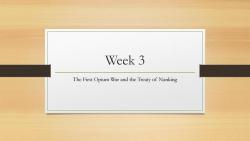
Week 3 The First Opium War and the Treaty of Nanking
Week 3 The First Opium War and the Treaty of Nanking
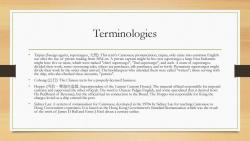
Terminologies Taipan(foreign agents,supercargos,):This term's Cantonese pronunciation,taipan,only came into common English use after the rise of private trading from 1834 on.A private captain might be his own supercargo;a large East Indiamen might have five or more,which were ranked"chief supercargo","2nd supercargo",and such.A team of supercargos divided their work,some overseeing sales,others tea purchases,silk purchases,and so forth.Permanent supercargos might divide their work by the order ships arrived.The bookkeepers who attended them were called "writers";those serving with the ship,who also checked these accounts,"pursers" Cohong(公行):The Chinese term for a properly--licensed business. Hoppo(C河伯、粤海矢监督,Superintendent of the Canton Custom House):The imperial official responsible for imperial customs and supervised the other officials.The word is Chinese Pidgin English,and some speculated that it derived from Hu Bu(Board of Revenue),but the official had no connection to the Board.The Hoppo was responsible for fixing the charges levied as a ship entered the port. Sidney Lau:A system of romanisation for Cantonese,developed in the 1970s by Sidney Lau for teaching Cantonese to Hong Government expatriates.It is based on the Hong Kong Government's Standard Romanisation which was the result of the work of James D Ball and Ernst J Eitel about a century earlier
Terminologies • Taipan (foreign agents, supercargos, 大班): This term's Cantonese pronunciation, taipan, only came into common English use after the rise of private trading from 1834 on. A private captain might be his own supercargo; a large East Indiamen might have five or more, which were ranked "chief supercargo", "2nd supercargo", and such. A team of supercargos divided their work, some overseeing sales, others tea purchases, silk purchases, and so forth. Permanent supercargos might divide their work by the order ships arrived. The bookkeepers who attended them were called "writers"; those serving with the ship, who also checked these accounts, "pursers". • Cohong (公行): The Chinese term for a properly-licensed business. • Hoppo (河伯、粤海关监督, Superintendent of the Canton Custom House): The imperial official responsible for imperial customs and supervised the other officials. The word is Chinese Pidgin English, and some speculated that it derived from Hu Bu(Board of Revenue), but the official had no connection to the Board. The Hoppo was responsible for fixing the charges levied as a ship entered the port. • Sidney Lau: A system of romanisation for Cantonese, developed in the 1970s by Sidney Lau for teaching Cantonese to Hong Government expatriates. It is based on the Hong Kong Government's Standard Romanisation which was the result of the work of James D Ball and Ernst J Eitel about a century earlier
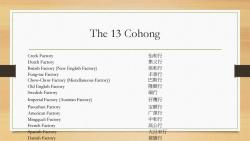
The 13 Cohong Creek Factory 怡和行 Dutch Factory 集义行 British Factory New English Factory) 保和行 Fung-tae Factory 丰泰行 Chow-Chow Factory (Miscellaneous Factory) 巴斯行 Old English Factory 隆顺行 Swedish Factory 瑞行 Imperial Factory (Austrian Factory) 孖鹰行 Paoushun Factory 宝顺行 American Factory 广源行 Mingqua's Factory 中和行 French Factory 高公行 Spanish Factory 大吕宋行 Danish Factory 黄旗行
The 13 Cohong Creek Factory 怡和行 Dutch Factory 集义行 British Factory (New English Factory) 保和行 Fung-tae Factory Chow-Chow Factory (Miscellaneous Factory) 丰泰行 巴斯行 Old English Factory 隆顺行 Swedish Factory 瑞行 Imperial Factory (Austrian Factory) 孖鹰行 Paoushun Factory 宝顺行 American Factory 广源行 Mingqua’s Factory 中和行 French Factory 高公行 Spanish Factory 大吕宋行 Danish Factory 黄旗行
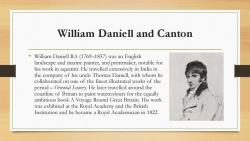
William Daniell and Canton William Daniell RA(1769-1837)was an English landscape and marine painter,and printmaker,notable for his work in aquatint.He travelled extensively in India in the company of his uncle Thomas Daniell,with whom he collaborated on one of the finest illustrated works of the period-Oriental Scenery.He later travelled around the coastline of Britain to paint watercolours for the equally ambitious book A Voyage Round Great Britain.His work was exhibited at the Royal Academy and the British Institution and he became a Royal Academician in 1822
William Daniell and Canton • William Daniell RA (1769–1837) was an English landscape and marine painter, and printmaker, notable for his work in aquatint. He travelled extensively in India in the company of his uncle Thomas Daniell, with whom he collaborated on one of the finest illustrated works of the period – Oriental Scenery. He later travelled around the coastline of Britain to paint watercolours for the equally ambitious book A Voyage Round Great Britain. His work was exhibited at the Royal Academy and the British Institution and he became a Royal Academician in 1822
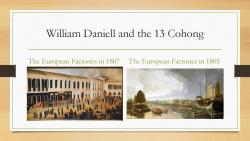
William Daniell and the 13 Cohong The European Factories in 1807 The European Factories in 1805
William Daniell and the 13 Cohong The European Factories in 1807 The European Factories in 1805
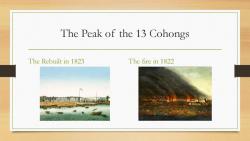
The Peak of the 13 Cohongs The Rebuilt in 1823 The fire in 1822
The Peak of the 13 Cohongs The Rebuilt in 1823 The fire in 1822
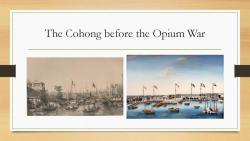
The Cohong before the Opium War
The Cohong before the Opium War
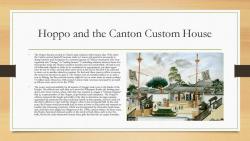
Hoppo and the Canton Custom House The Hoppo became central to China's trade relations with Europe after 1756,when the Canton system limited European trade to Canton and granted a monopoly in doing business with foreigners to a restricted group of Chinese merchants,who were organized into "Hongs,"or "trading houses."Controlling relations between these two monopoles made the Hoppo's position lucrative but not comfortable He had to pay off influential officials in order to be considered for appointment,pay them again once he was in office,and pay them once more at the end of his term if he expected to move on to another attractive position.He had only three years in office to recoup the money he had spent to gain it.The Hoppo sent an esimated million or so taels a year to Beijing,but his personal income might be tenor more times as much,perhaps 11 million taels.Moreover,18th century Canton trade revenues increased by as much as 300 per cent,most of it in the 1790s. The power and responsibility for all aspects of foreign trade were in the hands of the that is,a representative of the Hoppo,as go-between and interpreter.The Hoppo's officers measured the length and width of the ship to determine its cargo capacity, negotiated the pavments the ship would pay based on that capacity,and set a time for the ship's officers to meet with the Hoppo, often in his ceremonial hall.In the early years,the Hoppo would personally lead as many as forty or fifty junks and sampans to conduct the measuring ceremony,which was accompanied by fireworks,band music, and,until they were judged too dangerous n the 1780s,cannon salutes.In those years, the Hoppo bestowed impressive gifts on the newly arrived ships,such as two live bulls,but by the early nineteenth century these gifts had become an empty formaliry
Hoppo and the Canton Custom House • The Hoppo became central to China's trade relations with Europe after 1756, when the Canton system limited European trade to Canton and granted a monopoly in doing business with foreigners to a restricted group of Chinese merchants, who were organized into "Hongs," or "trading houses." Controlling relations between these two monopolies made the Hoppo's position lucrative but not comfortable. He had to pay off influential officials in order to be considered for appointment, pay them again once he was in office, and pay them once more at the end of his term if he expected to move on to another attractive position. He had only three years in office to recoup the money he had spent to gain it. The Hoppo sent an esimated million or so taels a year to Beijing, but his personal income might be ten or more times as much, perhaps 11 million taels. Moreover, 18th century Canton trade revenues increased by as much as 300 per cent, most of it in the 1790s. • The power and responsibility for all aspects of foreign trade were in the hands of the Hoppo. His officers met each ship as it arrived at Whampoa Roads, the landing spot down-river from Canton, where each ship was required to engage a "Chinese linguist," that is, a representative of the Hoppo, as go-between and interpreter. The Hoppo's officers measured the length and width of the ship to determine its cargo capacity, negotiated the payments the ship would pay based on that capacity, and set a time for the ship's officers to meet with the Hoppo, often in his ceremonial hall. In the early years, the Hoppo would personally lead as many as forty or fifty junks and sampans to conduct the measuring ceremony, which was accompanied by fireworks, band music, and, until they were judged too dangerous in the 1780s, cannon salutes. In those years, the Hoppo bestowed impressive gifts on the newly arrived ships, such as two live bulls, but by the early nineteenth century these gifts had become an empty formality
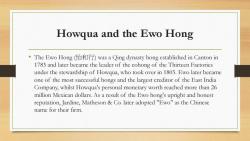
Howqua and the Ewo Hong The Ewo Hong(怡和行)was a Qing dynasty hong established in Canton in 1783 and later became the leader of the cohong of the Thirteen Factories under the stewardship of Howqua,who took over in 1803.Ewo later became one of the most successful hongs and the largest creditor of the East India Company,whilst Howqua's personal monetary worth reached more than 26 million Mexican dollars.As a result of the Ewo hong's upright and honest reputation,Jardine,Matheson Co.later adopted "Ewo"as the Chinese name for their firm
Howqua and the Ewo Hong • The Ewo Hong (怡和行) was a Qing dynasty hong established in Canton in 1783 and later became the leader of the cohong of the Thirteen Factories under the stewardship of Howqua, who took over in 1803. Ewo later became one of the most successful hongs and the largest creditor of the East India Company, whilst Howqua's personal monetary worth reached more than 26 million Mexican dollars. As a result of the Ewo hong's upright and honest reputation, Jardine, Matheson & Co. later adopted "Ewo" as the Chinese name for their firm
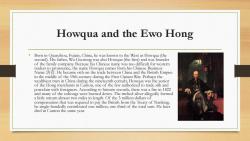
Howqua and the Ewo Hong Born in Quanzhou,Fujian,China,he was known to the West as Howqua(the second).His father,Wu Guorong was also Howqua(the first)and was founder of the family company.Because his Chinese name was too difficult for western traders to pronounce,the name Howqua comes from his Chinese Business Name.He became rich on the trade between China and the British Empire in the middle of the 19th century during the First Opium War.Perhaps the wealthiest man in China during the nineteenth century,Howqua was the senior of the Hong merchants in Canton,one of the few authorized to trade silk and porcelain with foreigners.According to historic records,there was a fire in 1822 and many of the cohongs were burned down.The melted silver allegedly formed a little stream almost two miles in length.Of the 3 million dollars of compensation that was required to pay the British from the Treaty of Nanking, he single-handedly contributed one million,one third of the total sum.He later died in Canton the same year
Howqua and the Ewo Hong • Born in Quanzhou, Fujian, China, he was known to the West as Howqua (the second). His father, Wu Guorong was also Howqua (the first) and was founder of the family company. Because his Chinese name was too difficult for western traders to pronounce, the name Howqua comes from his Chinese Business Name 浩官. He became rich on the trade between China and the British Empire in the middle of the 19th century during the First Opium War. Perhaps the wealthiest man in China during the nineteenth century, Howqua was the senior of the Hong merchants in Canton, one of the few authorized to trade silk and porcelain with foreigners. According to historic records, there was a fire in 1822 and many of the cohongs were burned down. The melted silver allegedly formed a little stream almost two miles in length. Of the 3 million dollars of compensation that was required to pay the British from the Treaty of Nanking, he single-handedly contributed one million, one third of the total sum. He later died in Canton the same year
按次数下载不扣除下载券;
注册用户24小时内重复下载只扣除一次;
顺序:VIP每日次数-->可用次数-->下载券;
- 《近代中国对外关系史 The History of Modern China's Foreign Relations》课程教学资源(PPT讲稿)Week 2 - The Collision of the Chinese and British Empires, 1792-1816.pptx
- 《近代中国对外关系史 The History of Modern China's Foreign Relations》课程教学资源(PPT讲稿)Week 16 - The Collapse of the Nationalist Government.pptx
- 《近代中国对外关系史 The History of Modern China's Foreign Relations》课程教学资源(PPT讲稿)Week 15 - The Pacific War, 1941-1945.pptx
- 《近代中国对外关系史 The History of Modern China's Foreign Relations》课程教学资源(PPT讲稿)Week 14 - The Second Sino-Japanese War, 1937-1941.pptx
- 《近代中国对外关系史 The History of Modern China's Foreign Relations》课程教学资源(PPT讲稿)Week 13 - The Nanjing Decade and the New Era of China's Diplomacy.pptx
- 《近代中国对外关系史 The History of Modern China's Foreign Relations》课程教学资源(PPT讲稿)Week 12 - The South Revolutionaries' Nationalistic Claims and Anti-Imperialistic Campaigns.pptx
- 《近代中国对外关系史 The History of Modern China's Foreign Relations》课程教学资源(PPT讲稿)Week 11 - China's Participation into the Global Order.pptx
- 《近代中国对外关系史 The History of Modern China's Foreign Relations》课程教学资源(PPT讲稿)Week 10 - The Early Republic's Diplomatic Difficulties.pptx
- 《近代中国对外关系史 The History of Modern China's Foreign Relations》课程教学资源(PPT讲稿)Week 1 - Introduction.pptx
- 《近代中国对外关系史 The History of Modern China's Foreign Relations》课程教学资源(PPT讲稿)What’s the Battle of Shanghai:new trial to research Sino- Japanese War by GIS.pptx
- 《中国近代史专题研究》课程教学资源(团练、水师与军阀)教学大纲 Research Topics on Modern Chinese History Militia, Navy and Warlordism.docx
- 《中国近代史专题研究》课程教学资源(团练、水师与军阀)第8周 袁氏四年、強人政治(中华民国北洋时期:北洋军阀之起源、袁世凯和洪宪帝制).pptx
- 《中国近代史专题研究》课程教学资源(团练、水师与军阀)第9周 府院之爭,張勳復辟(中华民国北洋时期:两次府院之争、北洋之虎、和南北战争).pptx
- 《中国近代史专题研究》课程教学资源(团练、水师与军阀)第7周 新建陸軍與袁世凱的崛起(北洋新軍與袁世凱).pptx
- 《中国近代史专题研究》课程教学资源(团练、水师与军阀)第6周 八國聯軍和武衛軍覆滅.pptx
- 《中国近代史专题研究》课程教学资源(团练、水师与军阀)第5周 甲午戰爭和淮軍覆滅.pptx
- 《中国近代史专题研究》课程教学资源(团练、水师与军阀)第4周 捻亂、回變與團練勢力的擴大 The Muslim Uprising and the Nian Bandits.pptx
- 《中国近代史专题研究》课程教学资源(团练、水师与军阀)第3周 團練的興起與太平天國的覆滅.pptx
- 《中国近代史专题研究》课程教学资源(团练、水师与军阀)第2周 綠營的覆滅與太平天國的興起 THE TAIPING HEAVENLY KINGDOM AND CENTRAL TROOPS OF THE QING EMPIRE.pptx
- 《中国近代史专题研究》课程教学资源(团练、水师与军阀)第1周 導言 Introduction.pptx
- 《近代中国对外关系史 The History of Modern China's Foreign Relations》课程教学资源(PPT讲稿)Week 4 - The Second Opium War and the Reconfirmation of the Treaty System.pptx
- 《近代中国对外关系史 The History of Modern China's Foreign Relations》课程教学资源(PPT讲稿)Week 5 - The Self Strengthening Movement and the CMCS, 1861-1885.pptx
- 《近代中国对外关系史 The History of Modern China's Foreign Relations》课程教学资源(PPT讲稿)Week 6 - Tributary States and the Sino-Foreign Conflicts.pptx
- 《近代中国对外关系史 The History of Modern China's Foreign Relations》课程教学资源(PPT讲稿)Week 7 - The Partition of China and the Hundred Days' Reforms.pptx
- 《近代中国对外关系史 The History of Modern China's Foreign Relations》课程教学资源(PPT讲稿)Week 8 - The Boxer War and the International Protocol.pptx
- 《近代中国对外关系史 The History of Modern China's Foreign Relations》课程教学资源(PPT讲稿)Week 9 - The New Policies Reforms and the Anglo-Japanese Alliance.pptx
- 《近代中国对外关系史 The History of Modern China's Foreign Relations》课程教学资源(阅读材料)Anglo-Chinese Diplomacy in the Sir John Jordan and Yuan Shih-k'ai(1906-1920).pdf
- 《近代中国对外关系史 The History of Modern China's Foreign Relations》课程教学资源(阅读材料)Anglo-Chinese Diplomacy in the Sir John Jordan and Yuan Shih-k'ai(1906-1920).pdf
- 《近代中国对外关系史 The History of Modern China's Foreign Relations》课程教学资源(阅读材料)Revisiting the Chinese Maritime Customs Service, 1854 –1950.pdf
- 《近代中国对外关系史 The History of Modern China's Foreign Relations》课程教学资源(阅读材料)Cambridge History of China Vol. 11 Ch 4 THE MILITARY CHALLENGE(THE NORTH-WEST AND THE COAST).pdf
- 《近代中国对外关系史 The History of Modern China's Foreign Relations》课程教学资源(阅读材料)China in Revolution(he First Phase,1900-1913).pdf
- 《近代中国对外关系史 The History of Modern China's Foreign Relations》课程教学资源(阅读材料)China's Struggle for Naval Development 1839-1895.pdf
- 《近代中国对外关系史 The History of Modern China's Foreign Relations》课程教学资源(阅读材料)SIR FREDERICK MAZE AND THE CHINESE hIARITIME CUSTOMS, 1937-1941.pdf
- 《近代中国对外关系史 The History of Modern China's Foreign Relations》课程教学资源(阅读材料)Embarrassed Monarchist:Frank J. Goodnow and Constitutional Development in China, 1913-1915.pdf
- 《近代中国对外关系史 The History of Modern China's Foreign Relations》课程教学资源(阅读材料)Fairbank, China New History(China's War of Resistance 1937-1945).pdf
- 《近代中国对外关系史 The History of Modern China's Foreign Relations》课程教学资源(阅读材料)Foreign Devils, Finance and Informal Empire:Britain and China c.1900–1912.pdf
- 《近代中国对外关系史 The History of Modern China's Foreign Relations》课程教学资源(阅读材料)Foreign-Training and China's Self-Strengthening(The Case of Feng-huang-shan, 1864——1873).pdf
- 《近代中国对外关系史 The History of Modern China's Foreign Relations》课程教学资源(阅读材料)晚清的幕府制度(Friends, Guests, and Colleagues).pdf
- 《近代中国对外关系史 The History of Modern China's Foreign Relations》课程教学资源(阅读材料)God's Chinese Son(THE SPLIT).pdf
- 《近代中国对外关系史 The History of Modern China's Foreign Relations》课程教学资源(阅读材料)Granville Loch, The Closing Events Of The CAMPAIGN IN CHINA.pdf
